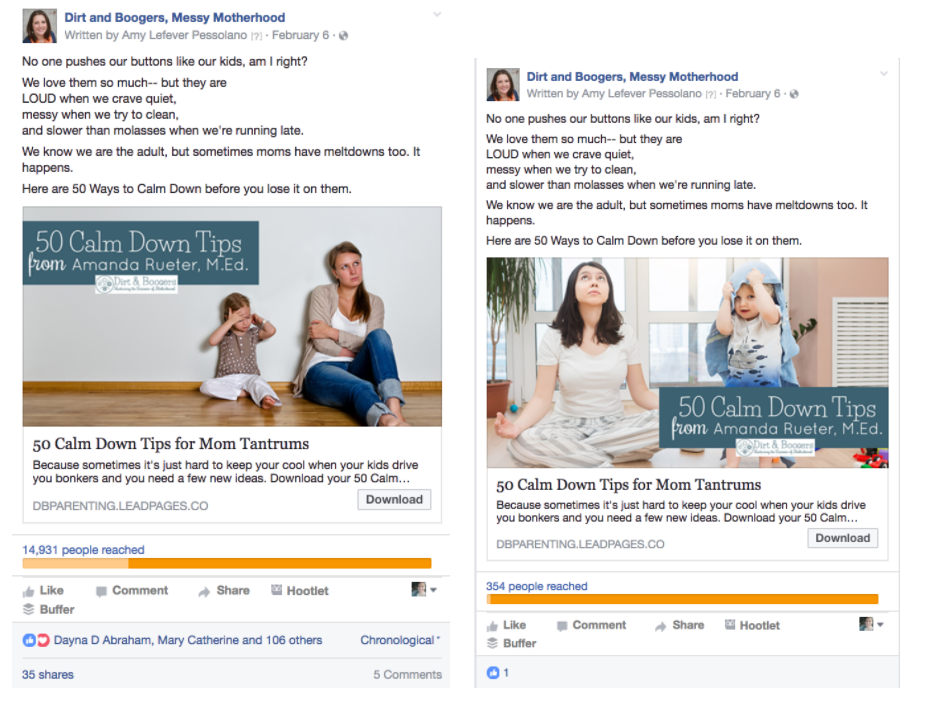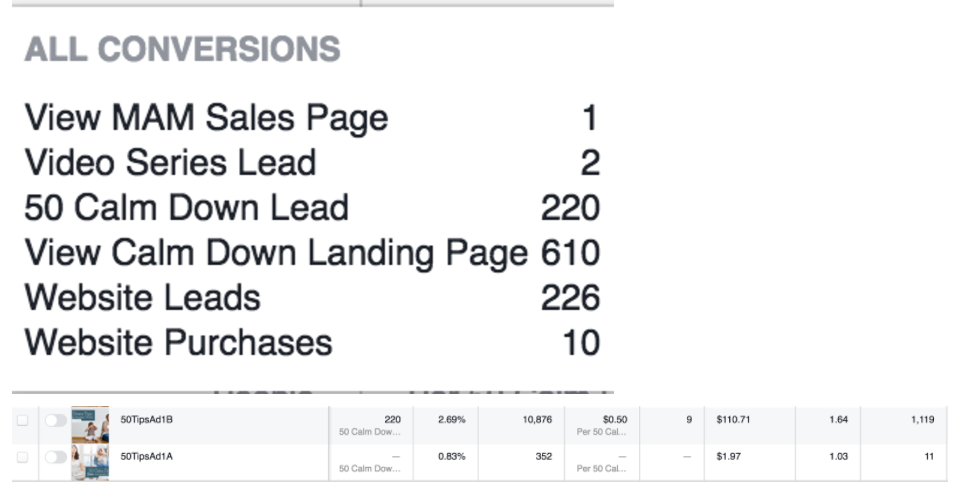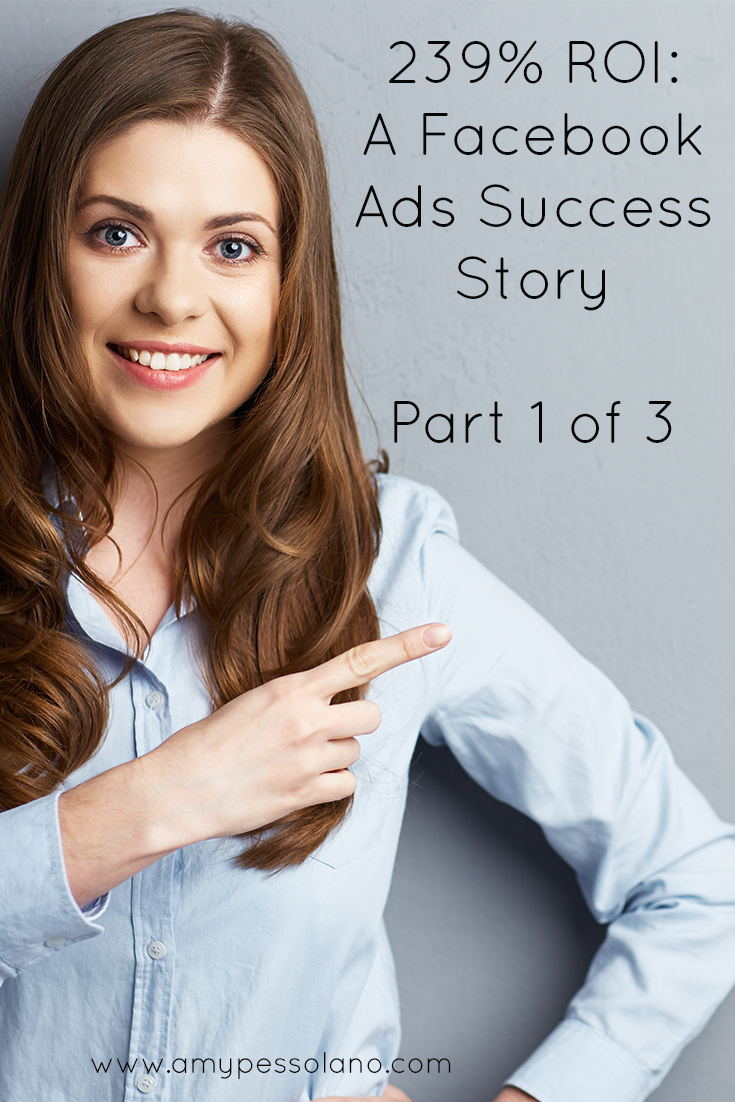I received a sample of this product in exchange for my review. However, I only recommend products or services I love, that I use personally and believe will be good for my readers. The links to Amazon in this post are affiliate links and I will be compensated if you make a purchase using them.
This post is the first in a series of case studies so you can see the thought process that goes into planning and executing an effective Facebook advertising campaign.
Sure, you could just “boost” an organic post to get your message in front of more eyeballs.
But just boosting posts willy-nilly won’t get you the kind of results I’m seeing pop up all over the internet lately boasting massive ROI. In fact, you could spend a lot of money and not get results. Which kind of defeats the purpose of paying for traffic, now doesn’t it?
Here’s the thing- when you’re launching a product, there are a lot of moving parts. In the “real world” a blogger launching a product is doing the jobs of multiple people.
Scratch that- careers of multiple people.
For an ad campaign alone, in an advertising agency, at a bare minimum, you’d find
- an account manager who works with the client
- a copywriter or a team of copywriters who do the writing
- an art director who plans the design
- and a creative who executes the design.
- Not to mention the traffic team that works as a liaison between all the departments to make sure the project is on time and budget.
What, you ask? All of those people for one simple advertising campaign? yep.
Is that level of bureaucracy necessary?- not always. But I just wanted to give you some perspective on the amount of work that goes into advertising campaigns in general.
Some Background Info and a Resource
In full disclosure, I have a Bachelor of Arts in Advertising from Penn State. BUT Facebook didn’t exist when I went to school. In fact, the entire marketing landscape seems vastly different these days. (In reality, Online Marketing is just Regular Old School Marketing in a different form…. but more on that later). I have to keep up on my skills by scouring the internet for articles, taking courses, and just doing the work.
Despite my background in Advertising, Sales, and most things direct marketing, Facebook ads intimidated me. I was nervous. And I almost talked my client out of Facebook ads because I wasn’t sure I was ready to run them and she would lose money.
She wanted to try it anyway.
So I bought the Absolute FB Ads Course from Claire Pelletreau and crammed my little butt off. Totally worth it, as you’ll see in the rest of this series. I also STILL continue to reference it and get support in the accompanying Facebook group, which is priceless.
If you’re a course creator or coach and you’re planning on attempting to run your own ads, this course is a must-buy. Especially since the price is going up May 1st from $297 to $997. I will still recommend it at $997- it’s totally worth it.
Using Facebook Ads to Generate Leads and Sell Courses
This product launch consisted of a series of 3-4 Campaigns over the course of 3 months. This is part one. I’m also planning to write more about how to think like a scientist when it comes to campaign planning and launching products, but that’s basically where I start.
With questions. And hypotheses.
So for the very first campaign we ran, we wanted to know simply, can we increase the number of subscribers on my client’s email list using Facebook ads and a proven lead magnet? What will it cost?
Keep it simple to start.
Assess what you know and what you want to test
We knew a few things going in.
- That the 50 Calm Down Tips has been successful in the past as a lead magnet organically, both when shared on the Dirt and Boogers Facebook page and when shared by affiliates.
- We also knew that once we had their email address, we could promote the Mama’s Anger Management course to them via email.
We also weren’t sure about a few things like,
- We weren’t sure if (or how soon) these leads would convert to buyers.
- We also wanted to know if we could generate revenue from cold traffic (people who had never heard of Dirt and Boogers before) by using a small offer (or tripwire) on the Thank you page.
Typically it’s pretty impossible to convert (or sell) offers to prospects directly via Facebook ads (or so I’m told). It’s like the holy grail to get an offer that converts cold traffic. And that’s why most people use sales funnels in conjunction with their Facebook ads.
If this is all sounding like a foreign language, make sure you grab my free glossary of sales and marketing terms here. (coming soon).
The Plan
We planned to run 2 ad sets, to test two different cold audiences. Each ad set would have one version of copy with 2 different images in each, A & B. After we determined a winning image we would test new copy. We ran the same image/copy combinations in both ad sets.
Ad Set 1 Ad Set 2
(Audience 1) (Audience 2)
Ads Ads
Ad 1A Ad 1B Ad 1A Ad2B
Ad 2A Ad 2B Ad 2A Ad2B
I admit, my plan to try advertising would not have been this organized or thorough without Claire’s course.
The Ads
So, as you can see, I made two different images and one set of copy to start with.
I researched what had done well organically in the past, starting with searching for places the blog post about these tips had gotten really big shares on Facebook. I pulled the concept of “Mom Tantrums” from one of those and made it the headline.
The rest of the copy came from audience research and personal experience.
Originally I planned to test a second version of copy with the winning image, but the ad on the left did so well, we decided to scrap the test and just go with the winning ad for now.

When you set up an ad in the Power Editor, you can customize the Text, Headline, Link Description and Call to Action button.
That’s a lot of variables to test.
So make sure you’re only changing one variable at a time.
The Results
Here are a few screenshots.

So what does that mean?
The important numbers are the views to the Calm Down Landing Page and 50 Calm Down Leads.
610 people clicked on the link in the ad and visited the landing page. 220 of them signed up.
To calculate the conversion rate use this equation:
Conversions divided by Clicks= Conversion Rate
220/610=.36 (x100)= 36%
This offer converted at 36% which is spot on with industry averages.
Since we put a small tripwire offer on the Thank You page- we were also able to get 10 purchases. That means the tripwire offer converted at 4.5% (which can hopefully be improved and will need to be for this funnel to be self-liquidating).
Some other important numbers to note:
- These ads had a click-through rate of 2.69% (anything above 1% is excellent),
- a relevance score of 9 (out of 10),
- and our average cost per lead was .50. (It’s best to estimate this at $2 a lead to be conservative. It also depends on your industry).
So we were pleasantly surprised with this result on the first try out of the gate.
Turns out we were able to get that cost even lower on our next campaign- so stay tuned!
Feedback from my Ad Mentor, Claire Pelletreau
I might be 37 years old, but a part of me is still like a kid in school trying to impress the teacher. So I was thrilled to be able to prove Claire wrong when she told me I wouldn’t be able to convert any sales from cold traffic when we opened the cart for the course.

I’ll be sharing the next two phases of these ad campaigns and how I put together those specific ads that converted cold traffic to course buyers, but here’s a sneak peek of the final results I shared with Claire and she sent out in an email to her list.
I’m really eager to follow along this case study. It’s part one but I’m already excited. Not many people know about audience split testing so looking forward to part 2 and 3.
And congrats on a whooping 239% ROI.